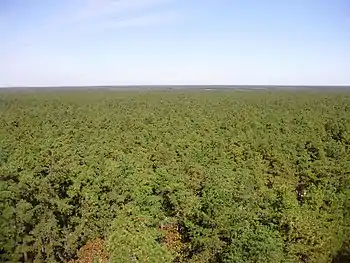Pine barrens
Pine barrens, pine plains, sand plains, or pinelands occur throughout the U.S. from Florida to Maine (see Atlantic coastal pine barrens) as well as the Midwest, West, and Canada and parts of Eurasia. Pine barrens are plant communities that occur on dry, acidic, infertile soils, dominated by grasses, forbs, low shrubs, and small to medium-sized pines. The most extensive barrens occur in large areas of sandy glacial deposits (including outwash plains), lakebeds, and outwash terraces along rivers.

Description
Botany
The most common trees are the jack pine, red pine, pitch pine, blackjack oak, and scrub oak; a scattering of larger oaks is not unusual. The understory includes grasses, sedges, and forbs, many of them common in dry prairies, and rare plants such as the sand-plain gerardia (Agalinis acuta). Plants of the heath family, such as blueberries and bearberry, and shrubs, such as prairie willow and hazel, are common. These species have adaptations that permit them to survive or regenerate well after fire.
Fauna
Pine barrens support a number of rare species, including Lepidoptera such as the Karner blue butterfly (Plebejus melissa samuelis) and the barrens buck moth (Hemileuca maia).
Fire ecology
Barrens are dependent on fire to prevent invasion by less fire-tolerant species. In the absence of fire, barrens will proceed through successional stages from pine forest to a larger climax forest, such as oak-hickory forest.[1]:118–20
European settlers found extensive areas of open game habitat throughout the East, commonly called "barrens". The American Indians used fire to maintain such areas as rangeland.[2] Open barrens are now rare and imperiled globally. Suppression of wildfires has allowed larger climax forest vegetation to take over in most one-time barrens. In North America, the largest natural pine barrens exist primarily in parts of the American Midwest and in dry sandy areas along the East Coast.
See also
References
- McPhee, John (1968). The Pine Barrens. Farrar, Straus, and Giroux. p. 118. ISBN 978-0-374-51442-6.
- Brown, Hutch (Summer 2000). "Wildland Burning by American Indians in Virginia". Fire Management Today. Washington, DC: U.S. Department of Agriculture, Forest Service. 60 (3): 30.
